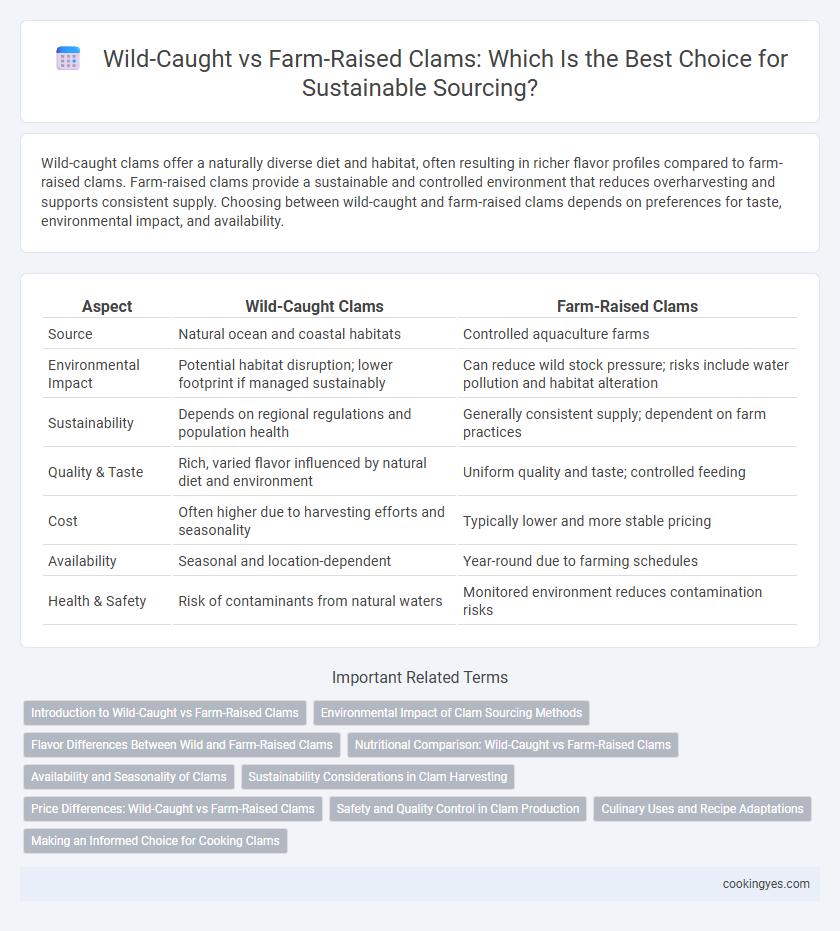Wild-caught clams offer a naturally diverse diet and habitat, often resulting in richer flavor profiles compared to farm-raised clams. Farm-raised clams provide a sustainable and controlled environment that reduces overharvesting and supports consistent supply. Choosing between wild-caught and farm-raised clams depends on preferences for taste, environmental impact, and availability.
Table of Comparison
| Aspect | Wild-Caught Clams | Farm-Raised Clams |
|---|---|---|
| Source | Natural ocean and coastal habitats | Controlled aquaculture farms |
| Environmental Impact | Potential habitat disruption; lower footprint if managed sustainably | Can reduce wild stock pressure; risks include water pollution and habitat alteration |
| Sustainability | Depends on regional regulations and population health | Generally consistent supply; dependent on farm practices |
| Quality & Taste | Rich, varied flavor influenced by natural diet and environment | Uniform quality and taste; controlled feeding |
| Cost | Often higher due to harvesting efforts and seasonality | Typically lower and more stable pricing |
| Availability | Seasonal and location-dependent | Year-round due to farming schedules |
| Health & Safety | Risk of contaminants from natural waters | Monitored environment reduces contamination risks |
Introduction to Wild-Caught vs Farm-Raised Clams
Wild-caught clams are harvested directly from their natural habitats, such as coastal waters and tidal flats, offering a taste that reflects the local marine ecosystem. Farm-raised clams are cultivated in controlled aquaculture environments, ensuring consistent supply and potentially reduced environmental impact through sustainable practices. Both sourcing methods influence clam flavor, texture, and ecological footprint, guiding consumer preferences and industry standards.
Environmental Impact of Clam Sourcing Methods
Wild-caught clams maintain natural population dynamics and biodiversity but can cause habitat disruption through dredging, impacting seafloor ecosystems. Farm-raised clams reduce pressure on wild stocks and often improve water quality by filtering excess nutrients, yet may risk localized pollution if farming density is unmanaged. Sustainable clam sourcing requires balancing these environmental trade-offs to protect marine habitats and ensure long-term ecosystem health.
Flavor Differences Between Wild and Farm-Raised Clams
Wild-caught clams typically offer a richer, brinier flavor due to their varied natural diet and environmental conditions, resulting in a more complex taste profile. In contrast, farm-raised clams often have a milder, cleaner flavor influenced by controlled feeding and habitat, which can lead to more consistent texture and freshness. Flavor differences are directly linked to their environment, diet, and water quality, making wild clams preferred for their distinctive, robust taste.
Nutritional Comparison: Wild-Caught vs Farm-Raised Clams
Wild-caught clams typically offer higher levels of omega-3 fatty acids and essential minerals like zinc and iron compared to farm-raised clams, which may contain more consistent protein content due to controlled feeding. Farm-raised clams benefit from regulated environments that minimize contaminants, but their nutrient density can be influenced by farming practices and water quality. Consumers seeking maximum nutritional benefits often prefer wild-caught clams for their richer micronutrient profile and natural diet.
Availability and Seasonality of Clams
Wild-caught clams are often subject to seasonal availability, with peak harvesting periods varying by region and environmental conditions, leading to fluctuations in supply. Farm-raised clams offer more consistent availability throughout the year due to controlled aquaculture practices that mitigate natural seasonal limitations. This reliability in sourcing makes farm-raised clams a preferred option for maintaining steady market supply and supporting year-round demand.
Sustainability Considerations in Clam Harvesting
Wild-caught clams are often considered more sustainable due to their natural habitat and minimal feed input, reducing environmental impact compared to farm-raised clams. However, overharvesting wild populations can lead to ecosystem imbalance and depletion of clam beds, necessitating regulated harvesting practices. Farm-raised clams typically offer controlled growth with lower bycatch risk and habitat disturbance, but require careful management to prevent pollution from nutrient runoff and disease spread.
Price Differences: Wild-Caught vs Farm-Raised Clams
Wild-caught clams often command higher prices due to their limited availability and the costs associated with sustainable harvesting from natural habitats. Farm-raised clams benefit from controlled environments and scalable production methods, resulting in lower prices and more consistent supply throughout the year. Market demand and environmental regulations also influence price fluctuations between wild-caught and farm-raised clam sources.
Safety and Quality Control in Clam Production
Wild-caught clams undergo natural environmental exposure, necessitating rigorous monitoring for contaminants and pathogens to ensure safety, while farm-raised clams benefit from controlled conditions with regular water quality testing and disease management protocols that enhance consistency and reduce contamination risks. Quality control in farm-raised clam production involves systematic screening for heavy metals, bacteria, and harmful algal toxins, often surpassing the variability found in wild populations. Both sourcing methods require adherence to stringent regulatory standards, but farm-raised clams typically offer more predictable quality and traceability due to managed cultivation environments.
Culinary Uses and Recipe Adaptations
Wild-caught clams offer a brinier flavor and firmer texture, ideal for raw preparations like ceviche or light sautees where the natural taste shines. Farm-raised clams provide a milder, more consistent flavor and softer texture, suitable for recipes requiring longer cooking times such as chowders or baked dishes. Recipe adaptations should account for these differences by adjusting cooking duration and seasoning intensity to enhance the clam's unique characteristics.
Making an Informed Choice for Cooking Clams
Wild-caught clams offer distinct flavor profiles and natural mineral content, reflecting their diverse marine habitats, while farm-raised clams provide consistent quality and sustainable sourcing. Understanding the differences in texture, taste, and environmental impact helps consumers select clams suited to specific recipes and dietary preferences. Prioritizing certified sustainable farms or reputable wild harvesters ensures the best quality and responsible clam sourcing for cooking.
Wild-caught vs farm-raised for clam sourcing Infographic

 cookingyes.com
cookingyes.com